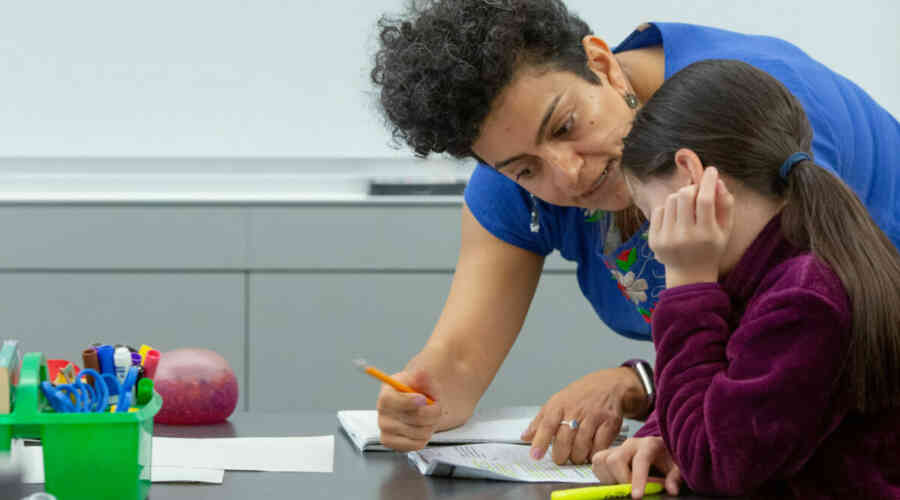Don't leave students with disabilities out of CA's massive community schools investment
May 1, 2023

| CREDIT: ALLISON SHELLEY FOR AMERICAN EDUCATION |
May 1, 2023

| CREDIT: ALLISON SHELLEY FOR AMERICAN EDUCATION |
This article was co-authored by Hayin Kimner, Managing Director of the CA Community Schools Learning Exchange (CSLX), and Kristen Wright, the Executive Director of Equity, Prevention and Intervention at the Sacramento County Office of Education.
California’s lowest-performing and most-segregated student group is at risk of being left out of one of the state’s most important education reforms – the unprecedented investment in community schools.
At both the February and April 2023 California Advisory Commission on Special Education meetings, state education leaders were asked if, where and how students with disabilities were intentionally included in the state’s largest one-time education investment to date: a $4.1 billion allocation for a competitive state grant program to support the planning and implementation of community schools.
The answer, in short – they were not.
Despite a decade of momentum, statutory assertions, statewide litigation, technical assistance dollars, bold statewide targets, and multiple edicts proclaiming California to be on the road to increased inclusivity and reduced segregation of students with disabilities, there is nothing notable to point to in the community schools grant applications or otherwise to ensure local educational agencies are intentionally planning for how students with disabilities will be included (and not segregated) in their transformation to community schools. This is a disappointing omission.
Contrary to common misperception, special education – by legal definition – is not a separate place nor a class that a student is “in.” The term refers to specially designed instruction, supports and services that enable a student with a disability to fully access and make progress in their academic and social-emotional learning alongside peers with and without disabilities. High-quality special education thrives within an integrated general education system, where universally designed teaching and learning and a mindset that all students belong and can achieve, is accompanied by a shared responsibility to ensure every student feels valued, supported and a deep sense of belonging.
Fortunately, these practices are also at the heart of successful and effective community school strategies.
A community school requires a fundamental repositioning of students and their families and a reimagining of how adults work together to create rich and inclusive learning opportunities for diverse learners. Students are more than diagnostic data points, clients, patients or individualized education programs (IEPs). They are not passive recipients of the expert knowledge of the adults around them. Every student is a central and dynamic component within a community; they are empowered and supported in the learning, health and welfare of themselves and their peers. They are learning from the subtleties of school who belongs and who does not. They are learning who has a rightful presence in their classrooms.
The state’s massive investment in community school implementation presents a timely convergence of research-based themes, including the science of learning and development, social-emotional learning, authentic family and community partnerships, and explicit naming of racist, ableist and isolating practices, that also lend themselves to inclusively serving students with disabilities.
Instead of cobbling together a patchwork of programs and partners that work in silos to “fix students,” community schools recognize the need to fundamentally “fix schools,” so that all students can succeed. This means applying what we know both from generations of great teaching practice and the newer science on learning, to reorganize and strengthen the structures, resources, relationships and practices of schooling so that students experience:
There are things the state can do right now to leverage this historic opportunity to increase inclusivity and belonging for students with disabilities:
Schools with existing community schools grants can also do more to include students with disabilities:
California’s community schools are part of a historic moment and an opportunity to prioritize intentional, inclusive belonging – relationship-centered, student-centered schools – as the basis for redesigning school for all students. We cannot look back in a decade with a “mea culpa” knowing that we may have left students with disabilities behind.
This commentary originally appeared in EdSource on May 1, 2023.
Hayin Kimner is the managing director of the CA Community Schools Learning Exchange, an organization that works with local education agencies, community partners and other youth- and family-serving organizations to strengthen community school strategy development and implementation.
Kristin Wright is the executive director of equity, prevention and intervention at the Sacramento County Office of Education. Wright previously served as the California state director of special education at the California Department of Education (CDE).